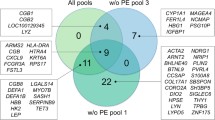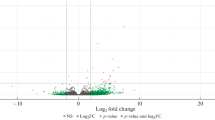Abstract
The aim of this study was to identify differentially expressed genes by suppression subtractive hybridization (SSH) in HELLP placentas. Two cDNA libraries were constructed; HSI (HELLP subtracted induced or upregulated) and HSS (HELLP subtracted suppressed or downregulated). Two hundred eighty-eight cDNA clones were sequenced; 37 were matched to GenBank entries and included genes in cell communication and organization, cellular processes, genetic information processing, and metabolic processes. A subgroup of 11 genes of interest was further selected for real-time quantitative polymerase chain reaction confirmation. Results showed no differences in expression of chosen upregulated genes between HELLP and non-HELLP placentas; 6 HELLP downregulated genes were significantly suppressed. Two genes related to production of secreted proteins, CTHRC1 and SERPINE2. SERPINE2 (PAI-1) is a soluble protease inhibitor and is a potential biomarker by Western blot analysis, and the protein is significantly decreased in HELLP placentas. SERPINE2 might be tested clinically in patients for early diagnosis of HELLP syndrome.
Similar content being viewed by others
References
Weinstein L. Syndrome of hemolysis, elevated liver enzymes, and low platelet count: a severe consequence of hypertension in pregnancy. Am J Obstet Gynecol. 1982;142:159–167.
Rebrikov D., Desai S., Kogan YN, Thornton AM, Diatchenko L. Subtractive cloning: new genes for studying inflammatory disorders. Ann Periodontol. 2002;7:17–28.
Diatchenko L., Lau YF, Campbell AP, et al. Suppression subtractive hybridization: a method for generating differentially regulated or tissue-specific cDNA probes and libraries. Proc Natl Acad Sci U S A. 1996;93:6025–6030.
Sibai BM, Taslimi MM, el-Nazer A., Amon E., Mabie BC, Ryan GM Maternal-perinatal outcome associated with the syndrome of hemolysis, elevated liver enzymes, and low platelets in severe preeclampsia-eclampsia. Am J Obstet Gynecol. 1986;155:501–509.
Kanehisa M., Goto S., Hattori M., et al. From genomics to chemical genomics: new developments in KEGG. Nucleic Acids Res. 2006;34:D354–D357.
Ashburner M., Ball CA, Blake JA, et al. Gene ontology: tool for the unification of biology. The Gene Ontology Consortium. Nat Genet. 2000;25:25–29.
Aarskog NK, Vedeler CA Real-time quantitative polymerase chain reaction: a new method that detects both the peripheral myelin protein 22 duplication in Charcot-Marie-Tooth type 1A disease and the peripheral myelin protein 22 deletion in hereditary neuropathy with liability to pressure palsies. Hum Genet. 2000;107:494–498.
Kay HH, Zhu S., Tsoi S. Hypoxia and lactate production in trophoblast cells. Placenta. 2007;28:854–860.
Bouton MC, Venisse L., Richard B., Pouzet C., Arocas V., Jandrot-Perrus M. Protease nexin-1 interacts with thrombomodulin and modulates its anticoagulant effect. Circ Res. 2007;100:1174–1181.
Chelbi ST, Mondon F., Jammes H., et al. Expressional and epigenetic alterations of placental serine protease inhibitors: SERPINA3 is a potential marker of preeclampsia. Hypertension. 2007;49:76–83.
Belo L., Santos-Silva A., Rumley A., et al. Elevated tissue plasminogen activator as a potential marker of endothelial dysfunction in pre-eclampsia: correlation with proteinuria. Br J Obstet Gynaecol. 2002;109:1250–1255.
Weiner CP Preeclampsia-eclampsia syndrome and coagulation. Clin Perinatol. 1991;18:713–726.
Gao J., Ye H., Serrero G. Stimulation of adipose differentiation related protein (ADRP) expression in adipocyte precursors by long-chain fatty acids. J Cell Physiol. 2000;182:297–302.
Fujimoto Y., Itabe H., Sakai J., et al. Identification of major proteins in the lipid droplet-enriched fraction isolated from the human hepatocyte cell line HuH7. Biochim Biophys Acta. 2004;1644:47–59.
Wang X., Reape TJ, Li X., et al. Induced expression of adipophilin mRNA in human macrophages stimulated with oxidized low-density lipoprotein and in atherosclerotic lesions. FEBS Lett. 1999;462:145–150.
Bildirici I., Roh CR, Schaiff WT, Lewkowski BM, Nelson DM, Sadovsky Y. The lipid droplet-associated protein adipophilin is expressed in human trophoblasts and is regulated by peroxisomal proliferator-activated receptor-gamma/retinoid X receptor. J Clin Endocrinol Metab. 2003;88:6056–6062.
Tobin KA, Harsem NK, Dalen KT, Staff AC, Nebb HI, Duttaroy AK Regulation of ADRP expression by long-chain polyunsaturated fatty acids in BeWo cells, a human placental choriocarcinoma cell line. J Lipid Res. 2006;47:815–823.
Saarikoski ST, Rivera SP, Hankinson O. Mitogen-inducible gene 6 (MIG-6), adipophilin and tuftelin are inducible by hypoxia. FEBS Lett. 2002;530:186–190.
Yao M., Huang Y., Shioi K., et al. Expression of adipose differentiation-related protein: a predictor of cancer-specific survival in clear cell renal carcinoma. Clin Cancer Res. 2007;13:152–160.
Yamauchi T., Kamon J., Ito Y., et al. Cloning of adiponectin receptors that mediate antidiabetic metabolic effects. Nature. 2003;423:762–769.
Kadowaki T., Yamauchi T., Kubota N., Hara K., Ueki K., Tobe K. Adiponectin and adiponectin receptors in insulin resistance, diabetes, and the metabolic syndrome. J Clin Invest. 2006;116: 1784–1792.
Chen J., Tan B., Karteris E., et al. Secretion of adiponectin by human placenta: differential modulation of adiponectin and its receptors by cytokines. Diabetologia. 2006;49:1292–1302.
Takemura Y., Osuga Y., Yamauchi T., et al. Expression of adiponectin receptors and its possible implication in the human endometrium. Endocrinology. 2006;147:3203–3210.
Meller M., Qiu C., Kuske BT, Abetew DF, Muy-Rivera M., Williams MA Adipocytokine expression in placentas from pre-eclamptic and chronic hypertensive patients. Gynecol Endocrinol. 2006;22:267–273.
Anderson PD, Mehta NN, Wolfe ML, et al. Innate immunity modulates adipokines in humans. J Clin Endocrinol Metab. 2007;92:2272–2279.
Mamiya N., Worman HJ Hepatitis C virus core protein binds to a DEAD box RNA helicase. JBiol Chem. 1999;274:15751–15756.
Owsianka AM, Patel AH Hepatitis C virus core protein interacts with a human DEAD box protein DDX3. Virology. 1999;257:330–340.
You LR, Chen CM, Yeh TS, et al. Hepatitis C virus core protein interacts with cellular putative RNA helicase. J Virol. 1999;73:2841–2853.
Abdelhaleem M., Maltais L., Wain H. The human DDX and DHX gene families of putative RNA helicases. Genomics. 2003;81:618–622.
Park SH, Lee SG, Kim Y., Song K. Assignment of a human putative RNA helicase gene, DDX3, to human X chromosome bands p11.3→p11.23. Cytogenet Cell Genet. 1998;81:178–179.
Rocak S., Linder P. DEAD-box proteins: the driving forces behind RNA metabolism. Nat Rev Mol Cell Biol. 2004;5:232–241.
Tanner NK, Linder P. DExD/H box RNA helicases: from generic motors to specific dissociation functions. Mol Cell. 2001;8:251–262.
Chao CH, Chen CM, Cheng PL, Shih JW, Tsou AP, Lee YH DDX3, a DEAD box RNA helicase with tumor growth-suppressive property and transcriptional regulation activity of the p21waf1/cip1 promoter, is a candidate tumor suppressor. Cancer Res. 2006;66:6579–6588.
Vaiman D., Mondon F., Garces-Duran A., et al. Hypoxia-activated genes from early placenta are elevated in preeclampsia, but not in intra-uterine growth retardation. BMC Genomics. 2005;6:111.
Apcher GS, Maitland J., Dawson S., Sheppard P., Mayer RJ The alpha4 and alpha7 subunits and assembly of the 20S proteasome. FEBS Lett. 2004;569:211–216.
Herrmann J., Lerman LO, Lerman A. Ubiquitin and ubiquitin-like proteins in protein regulation. Circ Res. 2007;100: 1276–1291.
Takabe W., Kodama T., Hamakubo T., et al. Anti-atherogenic antioxidants regulate the expression and function of proteasome alpha-type subunits in human endothelial cells. J Biol Chem. 2001;276:40497–40501.
Takabe W., Matsukawa N., Kodama T., Tanaka K., Noguchi N. Chemical structure-dependent gene expression of proteasome subunits via regulation of the antioxidant response element. Free Radic Res. 2006;40:21–30.
Zong C., Gomes AV, Drews O., et al. Regulation of murine cardiac 20S proteasomes: role of associating partners. Circ Res. 2006;99:372–380.
Pyagay P., Heroult M., Wang Q., et al. Collagen triple helix repeat containing 1, a novel secreted protein in injured and diseased arteries, inhibits collagen expression and promotes cell migration. Circ Res. 2005;96:261–268.
LeClair RJ, Durmus T., Wang Q., Pyagay P., Terzic A., Lindner V. Cthrc1 is a novel inhibitor of transforming growth factor-beta signaling and neointimal lesion formation. Circ Res. 2007;100: 826–833.
Author information
Authors and Affiliations
Corresponding author
Additional information
The authors wish to thank Dr E. Albert Reece for his support of this work.
Rights and permissions
About this article
Cite this article
Kang, BY., Tsoi, S., Zhu, S. et al. Differential Gene Expression Profiling in HELLP Syndrome Placentas. Reprod. Sci. 15, 285–294 (2008). https://doi.org/10.1177/1933719108314626
Published:
Issue Date:
DOI: https://doi.org/10.1177/1933719108314626




